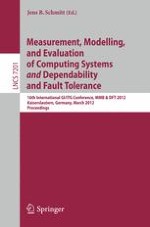2012 | Buch
Measurement, Modelling, and Evaluation of Computing Systems and Dependability and Fault Tolerance
16th International GI/ITG Conference, MMB & DFT 2012, Kaiserslautern, Germany, March 19-21, 2012. Proceedings
herausgegeben von: Jens B. Schmitt
Verlag: Springer Berlin Heidelberg
Buchreihe : Lecture Notes in Computer Science
